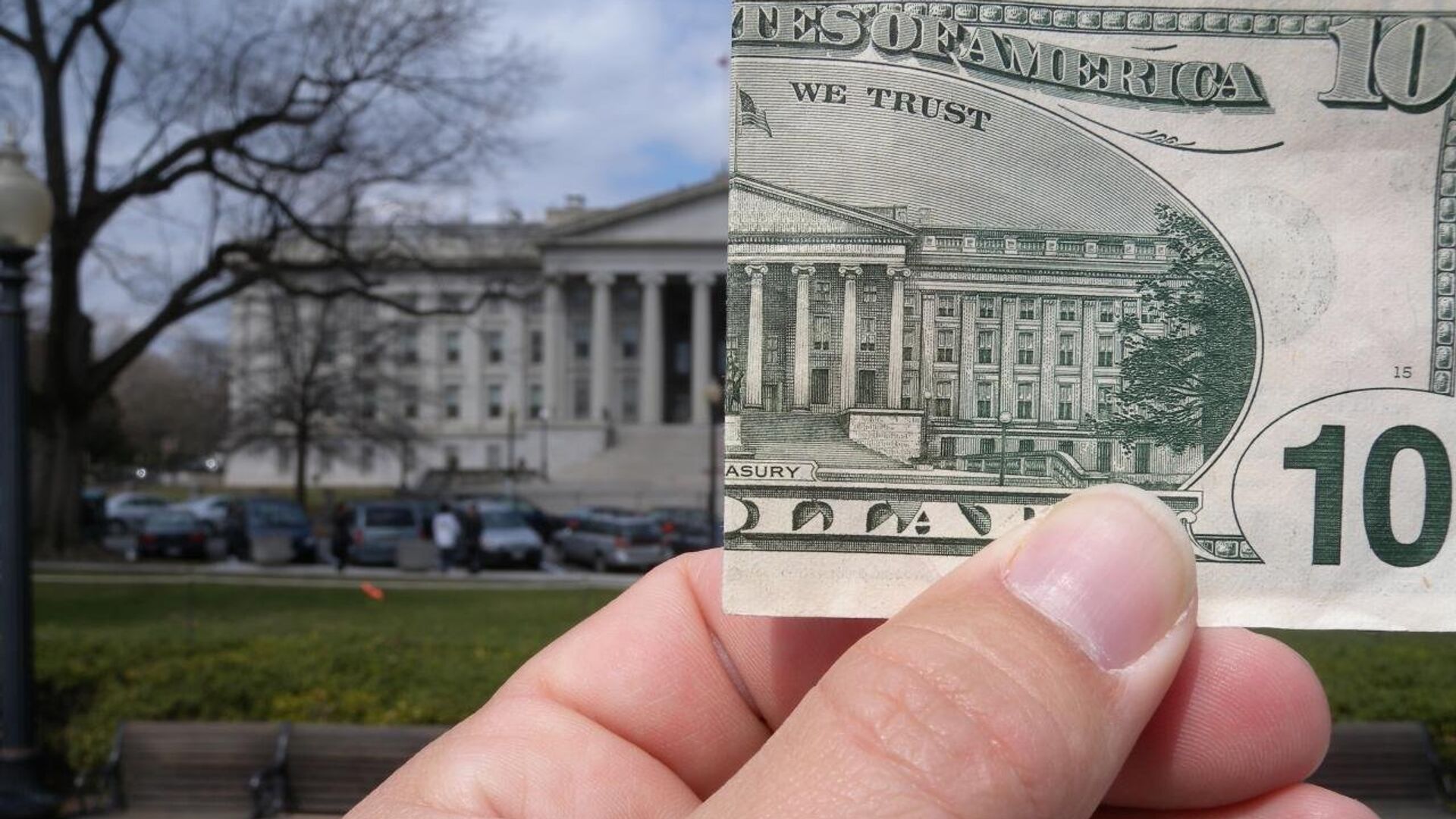https://sputnikglobe.com/20250102/new-year-old-debts-stage-set-for-congressional-free-for-all-over-painful-budget-cuts-1121338585.html
New Year, Old Debts: Stage Set for Congressional Free-For-All Over Painful Budget Cuts
New Year, Old Debts: Stage Set for Congressional Free-For-All Over Painful Budget Cuts
Sputnik International
Last week, Treasury secretary Janet Yellen warned the US would reach its new debt limit sometime between January 14-23, risking a government shutdown. Earlier, President-Elect Trump tried to strongarm lawmakers into upping limits to federal borrowing, or doing away with them altogether, with fiscal conservatives vowing to fight him over the issue.
2025-01-02T16:59+0000
2025-01-02T16:59+0000
2025-01-02T17:21+0000
americas
us
donald trump
janet yellen
washington
congress
soviet union
treasury
republican
https://cdn1.img.sputnikglobe.com/img/103428/15/1034281588_0:20:1280:740_1920x0_80_0_0_abace01764c808c82a9efbc56bcd1af0.jpg
The dreaded debt ceiling, i.e. congressionally-mandated restrictions on how much the federal government can borrow, officially returned on Thursday after a year-and-a-half-long break made possible by the misleadingly named Fiscal Responsibility Act of June 2023.The new ceiling, capping debt at the amount the US government owed as of the end of January 1, 2025 ($36.3 trillion and counting, according to usdebtclock.org), finds the US nearly $5 trillion deeper in debt than it was a year-and-a-half ago today, when total federal debt stood at $31.4 trillion.Technically, the maturity of an estimated $54 billion in securities will allow the Treasury to continue borrowing for a few weeks longer, after which it will be forced to trigger emergency measures, slashing services and halting salary payments to government employees to avoid a default.The exact date the crunch occurs remains a mystery, taking place anywhere from a week before Trump’s inauguration on January 20 to a few days afterward.The incoming president, aware of the fiscal hole his predecessors have left for him, is having none of it, seeking to rally allies in Congress to patch up the scary debt hole, either raising the limit or scrapping it altogether.But Trump could find himself at odds with what are ordinarily his most adamant supporters – fiscal conservatives, who proved their role as kingmakers with the 2023 ouster of House Speaker Kevin McCarthy, and could derail any future legislation they deem wasteful or unconducive to bringing down the deficit.In a joint appeal to Trump last week, 38 Republican lawmakers rejecting his proposal to put off borrowing restrictions for another two years, and demanding deep cuts in spending in exchange for support on raising the debt ceiling.“That debate’s going to be ongoing. I for one am going to do what I can to make sure the debt ceiling becomes more important,” Paul said.Republicans returning to Washington for a new session of Congress, which officially starts Friday, have been buoyed by their increased majority in the House, and have retaken the Senate, in November’s elections. Beltway pundits nevertheless fear that current House Speaker Mike Johnson may not be able to keep his caucus together in the coming months, and are uncertain whether lawmakers will be able to maintain a balance on what to cut and by how much.A Century-Old ProblemFirst introduced in 1917, when it was set at $11.5 billion (about $283.4 billion in today’s money, adjusted for inflation), the US federal debt ceiling has been raised more than 100 times in the 108 years since, with the 1917 ceiling now worth less than 0.8% of its current value.Out of control spending and debt accumulation began under the Reagan administration amid its Cold War arms buildup against the Soviet Union in the 1980s. The so-called ‘peace dividend’ of the 90s and 2000s, enjoyed partly thanks to the selloff of former Eastern Bloc resources and assets, combined with the dollar’s unique position as the de facto world reserve currency, shielded the US for years from the consequences that normally accompany high debt and inflationary spending.The rise of new centers of economic power such as BRICS, and the slowly fading luster of the dollar in international transactions thanks to its weaponization, have served to gradually undermine the US-led ‘rules-based international order’, and to accelerate the global economic and military competition for territory, resources and technology.
https://sputnikglobe.com/20241219/trump-threatens-government-with-total-paralysis-says-debt-ceiling-could-plunge-us-into-depression-1121216404.html
https://sputnikglobe.com/20241227/us-dollars-share-in-global-reserves-plunges-to-30-year-low---1121280436.html
americas
washington
soviet union
Sputnik International
feedback@sputniknews.com
+74956456601
MIA „Rossiya Segodnya“
2025
News
en_EN
Sputnik International
feedback@sputniknews.com
+74956456601
MIA „Rossiya Segodnya“
Sputnik International
feedback@sputniknews.com
+74956456601
MIA „Rossiya Segodnya“
is us headed for depression, is us in a recession, how much debt is us in, will us go bankrupt
is us headed for depression, is us in a recession, how much debt is us in, will us go bankrupt
New Year, Old Debts: Stage Set for Congressional Free-For-All Over Painful Budget Cuts
16:59 GMT 02.01.2025 (Updated: 17:21 GMT 02.01.2025) Last week, Treasury secretary Janet Yellen warned the US would reach its new debt limit sometime between January 14-23, risking a government shutdown. Earlier, President-Elect Trump tried to strongarm lawmakers into upping limits to federal borrowing, or doing away with them altogether, with fiscal conservatives vowing to fight him over the issue.
The dreaded debt ceiling, i.e. congressionally-mandated restrictions on how much the federal government can borrow, officially returned on Thursday after a year-and-a-half-long break made possible by the misleadingly named Fiscal Responsibility Act of June 2023.
The new ceiling, capping debt at the amount the US government owed as of the end of January 1, 2025 ($36.3 trillion and counting, according to
usdebtclock.org), finds the US nearly $5 trillion deeper in debt than it was a year-and-a-half ago today, when total federal debt stood at $31.4 trillion.
Technically, the maturity of an estimated $54 billion in securities will allow the Treasury to continue borrowing for a few weeks longer, after which it will be forced to trigger emergency measures, slashing services and halting salary payments to government employees to avoid a default.
The exact date the crunch occurs remains a mystery, taking place anywhere from a week before Trump’s inauguration on January 20 to a few days afterward.
The incoming president, aware of the fiscal hole his predecessors have left for him, is having none of it, seeking to rally allies in Congress to patch up the scary debt hole,
either raising the limit or scrapping it altogether.But Trump could find himself at odds with what are ordinarily his most adamant supporters – fiscal conservatives, who proved their role as kingmakers with the 2023 ouster of House Speaker Kevin McCarthy, and could derail any future legislation they deem wasteful or unconducive to bringing down the deficit.
In a joint appeal to Trump last week, 38 Republican lawmakers rejecting his proposal to put off borrowing restrictions for another two years, and demanding deep cuts in spending in exchange for support on raising the debt ceiling.
“We're about 33% overdrawn. We bring in about $4.8 trillion and spend $6.8 trillion, so you’ve got to get about $2 trillion worth of spending down,” veteran fiscal conservative Senator Rand Paul told The Hill earlier in the week, predicting that his allies in both chambers of Congress will support tying a new cap to major cuts.

19 December 2024, 18:34 GMT
What’s cut could prove a political hot potato nobody wants to be left holding, with cuts to Social Security, Medicare or Medicaid sure to impact lawmakers’ politically come reelection time, while slashing education, transportation or infrastructure could have long-term repercussions on the US economy and competitiveness against China. Cuts to national defense (close to $900 billion and counting) will be sure to provoke screaming in the Pentagon and threats from the US security and foreign policy establishment.
“That debate’s going to be ongoing. I for one am going to do what I can to make sure the debt ceiling becomes more important,” Paul said.
Republicans returning to Washington for a new session of Congress, which officially starts Friday, have been buoyed by their increased majority in the House, and have retaken the Senate, in November’s elections. Beltway pundits nevertheless
fear that current House Speaker Mike Johnson may not be able to keep his caucus together in the coming months, and are uncertain whether lawmakers will be able to maintain a balance on what to cut and by how much.
First introduced in 1917, when it was set at
$11.5 billion (about $283.4 billion in today’s money, adjusted for inflation), the US federal debt ceiling has been raised more than 100 times in the 108 years since, with the 1917 ceiling now worth less than 0.8% of its current value.
Out of control spending and debt accumulation began under the Reagan administration amid its Cold War arms buildup against the Soviet Union in the 1980s. The so-called ‘peace dividend’ of the 90s and 2000s, enjoyed partly
thanks to the selloff of former Eastern Bloc resources and assets, combined with the dollar’s unique position as the de facto world reserve currency, shielded the US for years from the consequences that normally accompany high debt and inflationary spending.
The rise of new centers of economic power such as BRICS, and the
slowly fading luster of the dollar in international transactions thanks to its
weaponization, have served to gradually undermine the US-led ‘rules-based international order’, and to accelerate the global economic and military competition for territory, resources and technology.

27 December 2024, 09:19 GMT




